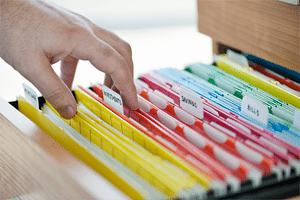
The No Surprises Act: Protecting Patients and Promoting Transparency
Legislation, Medical Billing Information, Medical OfficeThe No Surprises Act is a significant piece of federal legislation that aims to address the issue...

Efficiency in a medical office requires coordination between all doctors, nurses, and office staff. Coordination is built on a combination of communication and organization that fits the needs of all involved. No doctor or staff member has extra time to go searching through scattered patient files or documents spread across a desktop. Because the access to documents and other information cannot always be incorporated into an online database that sorts and searches in seconds, every medical office needs a set of physical filing systems to be efficient. In addition, medical filing systems act as a secure bank of private patient information; it’s crucial to care for the documents appropriately.
We’ve gathered some tips for establishing and maintaining medical filing systems:
Arrange files by one of the following: alphabetical, numerical, chronological. The most logical and popular arrangement for medical offices is by patient name or number, and then chronologically The problem with assigning numbers to patients is needing an individual step or key in order to process new documentation. It is also thought of as less personal. In addition to sorting within a file drawer by patient name or number, you might also have separate drawers or entire filing cabinets for different years or year ranges. That way, office staff can use the filing systems to locate old patient information without having to rifle past current patients. It also functions as a way to easily archive. For instance, filing cabinet X holds patient information that is more than five or ten years old.
A medical office should have primary filing drawers or cabinets with the most recent and current patients and secondary filing drawers or cabinets for archived patient information. The primary filing systems need to be stored within the reception area for easy and daily access. It might even be placed adjacent to the main desk as it will be opened and closed multiple times throughout the day to add new files and access recent ones. The secondary filing systems don’t necessarily need to be stored in the reception area or main office, depending on the space available. Archived files may even be kept in an entirely separate back room.

A good filing system should not be so specific to have only one piece of paper in each file folder, nor should it be so broad as to have each folder stuffed with and overflowing with documents that have to be additionally sorted. Labels should be clear and concise; highlights and funny fonts are just distracting. Make sure folder tabs are clearly visible. This does not mean you have to use the staggered method. In fact, many offices prefer lining up all folder tabs on one side or the other to reduce complications when files are added or subtracted.
The general rule for efficient filing systems is that you should be able to find a specific document in 20 seconds or less. In addition, you should be able to incorporate new folders and files without jamming a drawer, causing tabs to be out of alignment, or having to resort documents. All of these things take extra time that your staff could be using to give attention to patients in need.
All medical office filing systems should include a procedure to destroy old documents. If a patient gets transferred, requests a record elimination, or simply disappears for over ten years, those documents need a safe way to be eliminated. Usually, this means a combination of shredding all paperwork and/or disposing of the remains in a locked garbage receptacle.
In addition, all documents stored in medical filing systems should be protected within the office. This means locking filing cabinets that are not in use and making sure all are locked and secure at the end of each business day.
From better organization to security of patient information, medical filing systems can be complicated. More and more files are being transferred and stored directly onto a computer system rather than a physical one, but filing systems are still necessary for in-house documentation, medical release forms, etc. The efficiency of your medical office depends on this kind of organization, which enables processes like medical billing to be handled with more ease.
If medical billing is viewed as just another complication for your office that’s already swamped in paperwork, consider outsourcing the process to Billing Advantage. Contact Billing Advantage to see how we can help take the stress of organizing medical billing off of your shoulders for a more efficient office!

The No Surprises Act is a significant piece of federal legislation that aims to address the issue...

Medical practice marketing is often thought of as the mere use of billboards, print ads, and mail...

A medical practice consultant is a reliable outside source that can provide valuable feedback and guide a...

Patient satisfaction translates to dollars, whether positive or negative, in a medical practice. Managing satisfaction by serving...

Medical coding certification starts with a basic understanding of the medical facility’s practice management. When a patient...

Many physician billing systems are outdated, especially considering the ever-changing face of medical billing management. Not only...

Physician credentialing is a necessary step for all doctors founding or entering a practice, and should be...

Medical billing management and medical claims management are two time-consuming facets of running a medical facility. However,...

What is revenue cycle management and why is it important for your health care organization? To answer...
Contact us today to ensure your office is getting paid for the work that you do.